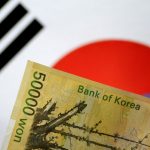
(Reuters) – Short bets on most Asian currencies firmed to touch multi-month highs as growing expectations of U.S. interest rates staying higher for longer dampened appetite for riskier assets, a Reuters poll showed on Thursday.
Bearish positions on the South Korean won, the Singapore dollar, the Philippine peso and the Thai baht rose to their highest level since mid-October 2022, according to a fortnightly poll of 12 analysts.
“Most EM risk premium is low when considering how much yields have converged, if not have been overtaken, by those in the U.S. So the willingness to have open EM FX exposures in some local fixed income is less compelling,” HSBC said in a note.
“A lot more is needed for EM FX to begin to bloom, including the Fed and major central banks to start easing and global growth to shift onto a convincing upturn,” it added.
Most of the poll responses came before the U.S. Federal Reserve held interest rates steady on Wednesday.
Chair Jerome Powell said rate increases remained unlikely, but he set the stage for a potentially extended hold of the benchmark policy rate in the 5.25%-5.50% range, noting the recent disappointing inflation readings.
If the Fed does not cut rates this year, Asian currencies might not get a breather and would risk seeing another year of depreciation against the U.S. dollar, which has so far remained buoyant, analysts said.
Christopher Wong, a currency strategist at OCBC said that renewed weakness in the Chinese yuan and the yen can also undermine the sentiment towards Asian currencies.
Bearish bets on the yuan, which logged a fourth straight monthly decline in April, remained unchanged from a fortnight ago.
Investors raised their short positions on the Indian rupee after turning bearish on the currency for the first time in four months only a fortnight ago.
Short positions on the Indonesian rupiah were the highest in six months, while those on the Malaysian ringgit were the highest since last July.
The rupiah has been trading around 16,200 per dollar levels since the middle of April and has fallen more than 4% so far this year.
Bank Indonesia raised its policy rates last week to support the rupiah, and has been intervening to defend the currency amid global uncertainty about the timing of U.S. rate cuts and tensions in the Middle East.
“For IDR and INR, we still expect interventions by the authorities aiming at curbing volatilities in case the USD becomes stronger,” said Ryota Abe, an economist with Sumitomo Mitsui (NYSE:SMFG) Banking Corp.
Analysts at HSBC said that the won and the baht could recover more than their peers in case the Fed embarks on its rate cut cycle in the second half of the year and geopolitical risks are manageable.
The Asian currency positioning poll is focused on what analysts and fund managers believe are the current market positions in nine Asian emerging market currencies: the Chinese yuan, South Korean won, Singapore dollar, Indonesian rupiah, Taiwan dollar, Indian rupee, Philippine peso, Malaysian ringgit and the Thai baht.
The poll uses estimates of net long or short positions on a scale of minus 3 to plus 3. A score of plus 3 indicates the market is significantly long U.S. dollars.
The figures include positions held through non-deliverable forwards (NDFs).
The survey findings are provided below (positions in U.S. dollar versus each currency):
DATE USD/CNY USD/KRW USD/SGD USD/IDR USD/TWD USD/INR USD/MYR USD/PHP USD/THB
02-May-24 1.25 1.61 0.89 1.39 1.40 0.49 1.46 1.44 1.39
18-Apr-24 1.25 1.59 0.80 1.32 1.24 0.43 1.42 1.19 1.28
4-Apr-24 1.18 1.09 0.42 1.13 1.17 0.00 1.15 0.62 1.35
21-Mar-24 0.92 0.82 0.33 0.60 0.92 -0.54 1.12 0.47 1.13
7-Mar-24 0.84 0.54 0.25 0.53 0.64 -0.59 1.14 0.52 1.05
22-Feb-24 0.70 0.40 0.20 0.20 0.70 -0.40 1.30 0.30 1.10
8-Feb-24 0.40 0.39 0.41 0.40 0.32 -0.17 1.07 0.28 0.72
25-Jan-24 0.37 0.90 0.28 0.51 0.49 -0.18 1.21 0.50 0.90
11-Jan-24 0.18 0.30 0.02 0.19 0.05 -0.15 0.72 0.09 0.03
To read the full article, Click Here

